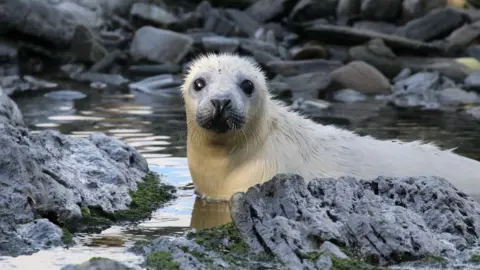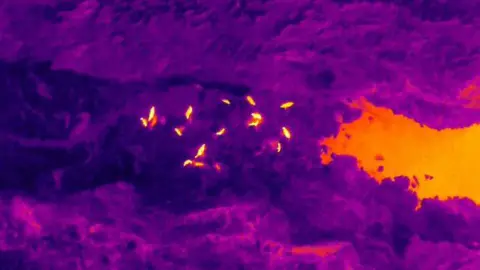Thermal drone ‘game-changer’ for seal surveys
 Lara Howe/MWT
Lara Howe/MWTNew drone technology was a “game-changer” for teams gathering data about seals on the Calf of Man this year, conservationists have said.
A total of 98 seal pups were recorded and monitored during the 10-week survey, which was the highest number since the recordings began in 2009.
Manx Wildlife Trust marine officer Lara Howe said the seals were “very well camouflaged against the rocks”, but thermal imaging made them “super easy to spot”.
The surveys were important as they gave the trust an indication of the "overall health of the ecosystem" because the animals "help to keep it in balance”, she said.
The findings, gathered through drone footage, contribute the understanding of seal population dynamics and habitat conservation efforts in the region, the trust said.
 Manx Wildlife Trust
Manx Wildlife TrustDr Howe said the new thermal imagining drone, purchased through funding from various local groups and organisations, meant it was easier to identify the seals and extra data could be collected.
It had enabled researchers to identify and count seals through their heat signatures from an "unobtrusive distance, even in poor visibility conditions", she continued.
That ensured seals were not disturbed, leading to "more accurate behavioural observations and population counts", including studying them at their most vulnerable, like suckling with their pup, the marine officer said.
"We hope to use it for island-wide seal surveys in the future too," she added.
 MWT
MWTThe trust said grey seals were highly sensitive to human presence, particularly during critical times like the pupping season, and disturbances could cause seals to abandon their young, disrupt breeding activities, and alter behaviour.
Efforts to mitigate human impacts on seal habitats were "crucial" for the continued conservation of the population on the Calf of Man, it added.
Why not follow BBC Isle of Man on Facebook and X? You can also send story ideas to [email protected]
